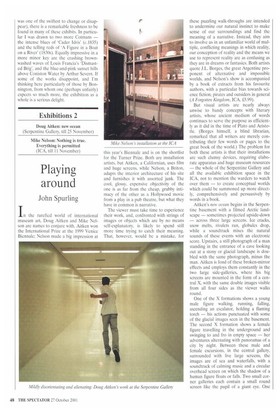Exhibitions 1
The Golden Age of Watercolours: The Hickman Bacon Collection (Dulwich Picture Gallery, London SE21, till 6 January 2002)
Serious delights
Andrew Lambirth
The Hickman Bacon Collection, amassed during the early years of the 20th century, is the most important group of English watercolours still in private hands. Sir Hickman Bacon (1855-1945), or 'greatuncle Hick-y' as the present owner of the collection, Sir Nicholas Bacon, endearingly calls him, was active in the property market, in public service (mostly in Lincolnshire), and was a racing driver as well as a passionate collector. He collected fabrics, ceramics and Japanese prints as well as paintings. His complete collection of watercolours and drawings numbers more than 400 items; the show at Dulwich selects some 80 works only, concentrating on the best and the most typical.
Sir Hickman bought when the late 'abstract' Turners were unfashionable, and before John Sell Cotman had been given his first major posthumous showing, at the Tate Gallery in 1922. Thus he was able to snap up works of a quality which would later have been totally inaccessible at the prices he paid. The bejewelled display at Dulwich bears ample witness to Sir Hickman's foresight.
Of course, landscape and watercolour go together like the proverbial horse and carriage, and the lengthy flowering of this particular marriage took place in England during the 18th and 19th centuries. This is the golden age of the exhibition's title, and although many of the great watercolourists are represented in the Hickman Bacon Collection, it is soon evident from the various omissions that the buyer of these works was a man of very particular taste. For instance, there is nothing by Constable, nor by Blake or Palmer. Nor, among the goodly array of Turners, are there any of the highly finished topographical images that formed such a significant portion of his output. It seems that Bacon was drawn more to the suggestive rather than the overtly descriptive, to the 'impressionistic' — which would explain why he bought none of the bold linearities of Francis Towne, but not why Alexander Cozens (father of John Robert Cozens, exhibited here), that master of the dramatic 'Blot' landscape, is missing from this display.
Be that as it may, the exhibition is full of treasures. Look at the uncompromising drawing of a mill in Essex (c.1799) by Thomas Girtin. Although almost monochrome, it is rich in graphic freedom, filled with the flicks and dashes of Girtin's lively shorthand. An early Turner of Malmesbuty Abbey (c.1791), done in pen and brown ink and watercolour, has a surprisingly modern look, almost as if it were drawn by John Piper in the 1940s or 1950s. Compare this to the much later, wonderfully spare Turners, often painted on different coloured papers (blue-grey, buff or grey), such as 'A Boat and Red Buoy in a Rough Sea' (c.1830). These rely for their effects on finely judged colour accents and touches of white gouache, and especially on the knowledge of what to leave out.
Colman, one of the greatest masters of watercolour, is here represented by quite a range of work. Particularly interesting is 'Scene in the Black Country' (c.1802), an industrial subject, romantically handled, full of texture and heavy with atmosphere. Cotman also experimented with different sorts of paper: 'Richmond, Yorkshire' (c.1805) was painted on absorbent wrapping paper, which helped to flatten the colours (as he wanted) and increase the element of overall pattern or design. There were, however, two sides to Getman, the other consisting of a deep fascination for architectural detail — see the adjacent watercolour and pencil drawing of a screen in Norwich Cathedral. There are further classic Cotmans, including 'New Bridge, Durham', and 'A Beached Barge near Battersea Bridge', which is still wonderfully crisp in presentation.
One picture at least shows the susceptibility of watercolours to fading when exposed to direct sunlight. Although Sir Hickman Bacon was reputed to keep his pictures piled up in a cupboard, in their card mounts only, the frames discarded, it is clear from a close examination of Girtin's painting 'The River Wharfe' that considerable fading has at some point taken place. If you study the lower edge of the composition you will find a band of darker greeny-blue which continues more or less visibly right round the work, as if this strip has been hidden from the light by a previous frame. If you then in imagination apply that deeper colouration to the whole picture, it comes as something of a shock to realise what a pale and faded version of the original we must be seeing today.
Yet, despite the notoriously fugitive nature of some pigments then used (indigo was one of the swiftest to change or disappear), there is a remarkable freshness to be found in many of these exhibits. In particular I was drawn to two more Cotmans — the intense blues of `Cader Idris' (c.1835) and the telling reds of 'A Figure in a Boat on a River' (1830s). Equally impressive in a more minor key are the crashing brownwashed waves of Louis Francia's Dismastcd Brig', and the blue-and-pink sunset hills above Coniston Water by Arthur Severn. If some of the works disappoint, and I'm thinking here particularly of those by Bonnington, from whom one (perhaps unfairly) expects so much more, the exhibition as a whole is a serious delight.











































































 Previous page
Previous page